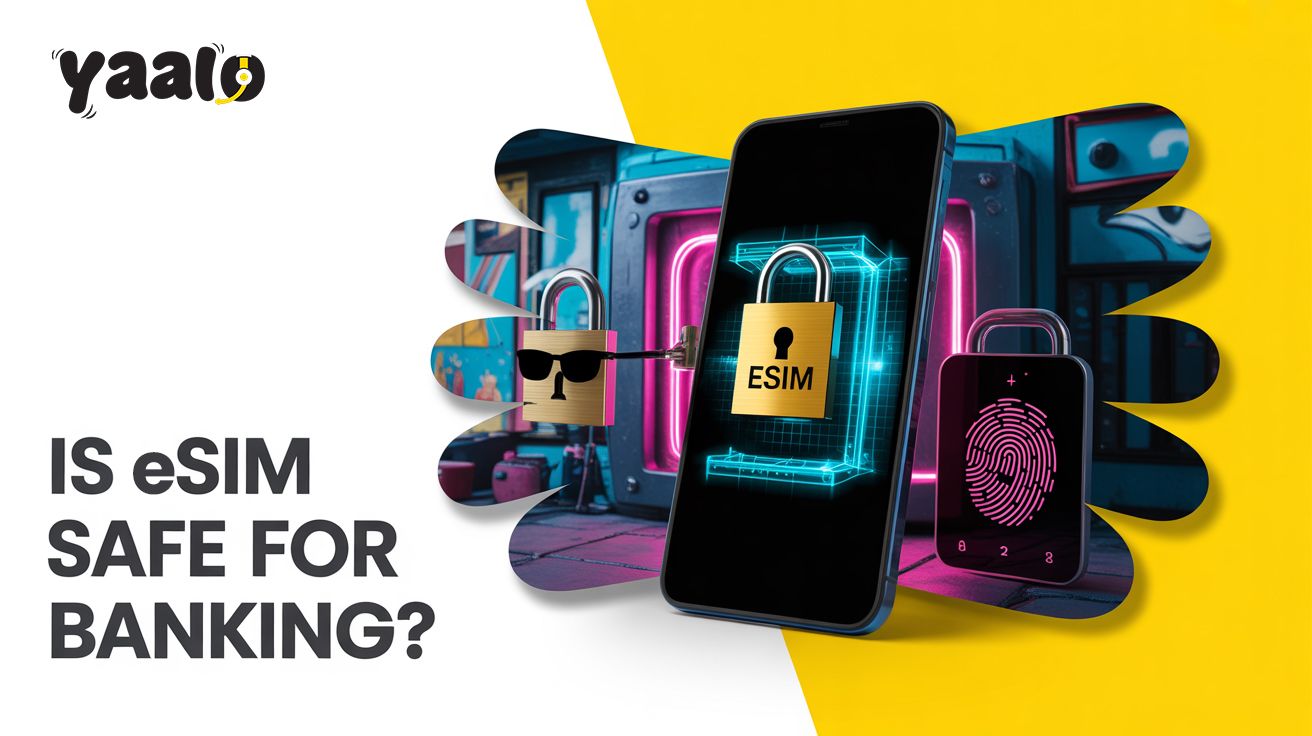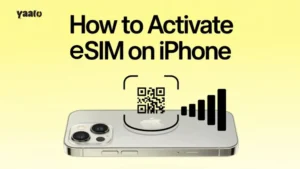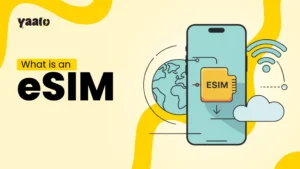You’re sipping espresso in a sunlit café in Lisbon. Glancing at your phone to pay a bill back home or transfer rent. It’s a normal task, but inside your head, there is a question:
“Is this even safe?”
You’re using an eSIM on a local network in a foreign country. Your bank app opens in a second. Seamless. But that doubt creeps in again.
More travelers are using eSIMs for mobile connectivity. This is especially true for digital nomads and remote workers. Because of this, the question is more important than ever:
Can you trust eSIM technology with your financial life? Or Is eSIM Safe for Banking?
Let’s walk through everything you need to know in plain language, with real-world insight and zero fluff.

What is an eSIM? (And Why It Matters for Banking)
An eSIM is an embedded SIM card built into your phone. Unlike physical SIM cards, there’s no need to pop anything in or out. You simply scan a QR code, and you connect to a network. It’s flexible, fast, and incredibly traveler-friendly.
For mobile banking, this matters. Your connection is now digital. It is important to understand how this affects your personal data, privacy, and device security.
Why eSIM Is Safer Than You Might Think?
Let’s address the big worry: Can someone steal your eSIM and hack your bank?
The answer is that eSIMs are inherently more secure than traditional SIMs because:
- No Physical Access Needed: No one can physically remove or perform SIM swapping.
- Carrier-Grade Encryption: Sensitive Data is transmitted with stronger security layers.
- Profile Locking: Your eSIM profile can be protected with passwords, PINs, and biometric authentication login.
- Remote Wipe Capability: Lose your phone? Your eSIM can be disabled remotely.
When used on a secure device with proper habits, eSIMs make banking safer—not riskier.
Real Risks: Where eSIM and Banking Can Go Wrong?
While eSIMs are secure by design, vulnerabilities exist when human habits fail or if the provider lacks proper safeguards. Let me tell you where things can go sideways:
- QR Code Exposure: Sharing or storing your eSIM activation QR code in your email can be dangerous.
- Weak Account Protection: Not using 2FA (two-factor authentication 2fa) or screen locks invites trouble.
- Public Wi-Fi Dangers: Accessing mobile banking on open networks without a VPN can expose your data.
- Social Engineering Attacks: Hackers may trick mobile carriers into transferring your number.
The tech is solid, but your personal behaviour plays a big role in banking safely. If you follow some safety habits, you won’t have any problems. You can feel safe using eSIM banking.
How to Keep Mobile Banking Secure with eSIM
No matter if you are banking in Bali or budgeting in Berlin, here are some tips to stay safe. These good habits will help you feel secure.
- Use 2FA on All Banking Apps: Every login should require verification.
- Avoid Public Wi-Fi Without VPN: It’s like sending your bank info on a postcard.
- Keep Your Device OS Updated: Updates patch security measures and flaws.
- Delete the eSIM QR After Setup: Never store or screenshot it.
- Use Strong Passwords + Biometrics: A simple PIN isn’t enough.
- Secure Your Email: Many hacks begin by breaching your inbox.
These simple habits put you miles ahead in mobile banking safety.
Why is Yaalo eSIM the Right Choice for Secure Banking?
Not all eSIM providers prioritise your security advantages. But Yaalo stands apart and offers you a threatening approach to eSIM banking:
- Encrypted Provisioning Process: Your data is never exposed.
- Banking-Friendly Compatibility: Works seamlessly with secure devices.
- Zero Bloat, Zero Risks: No third-party tracking or spyware.
- 24/7 Support: Real humans, always ready to help if something goes wrong.
Yaalo goes beyond staying connected. It’s about doing so securely, wherever you go.
Conclusion: Your Money Deserves Safe Travels
Using an eSIM for banking is not just safe; it can be safer than a traditional SIM. This is especially true for travelers who need quick and reliable connectivity.
The key is understanding the technology, practising smart digital hygiene, and choosing a provider that respects your privacy.
So next time you’re on the move, order that latte, check your balance, and travel on. With Yaalo, your connection—and your bank account—is in good hands.
FAQs
Is eSIM safer than a physical SIM for banking?
Yes. eSIMs are harder to steal, clone, or swap, making them more secure for mobile banking.
Can someone hack my eSIM and access my bank account?
It’s highly unlikely if you use 2FA and protect your eSIM QR code.
Is it safe to bank on public Wi-Fi with an eSIM?
Only if you use a trusted VPN. Also, Avoid logging into banking apps on open mobile networks.
What makes Yaalo eSIM secure for travelers?
Encrypted provisioning, trusted carriers, and responsive human support give Yaalo an edge.
- What is eSIM, and How Does it Work? - October 7, 2025
- Is eSIM Safe for Banking? Guide for Secure Mobile Banking! - October 1, 2025
- eSIM Compatible Laptops: Ultimate Guide and List for 2025! - September 30, 2025







